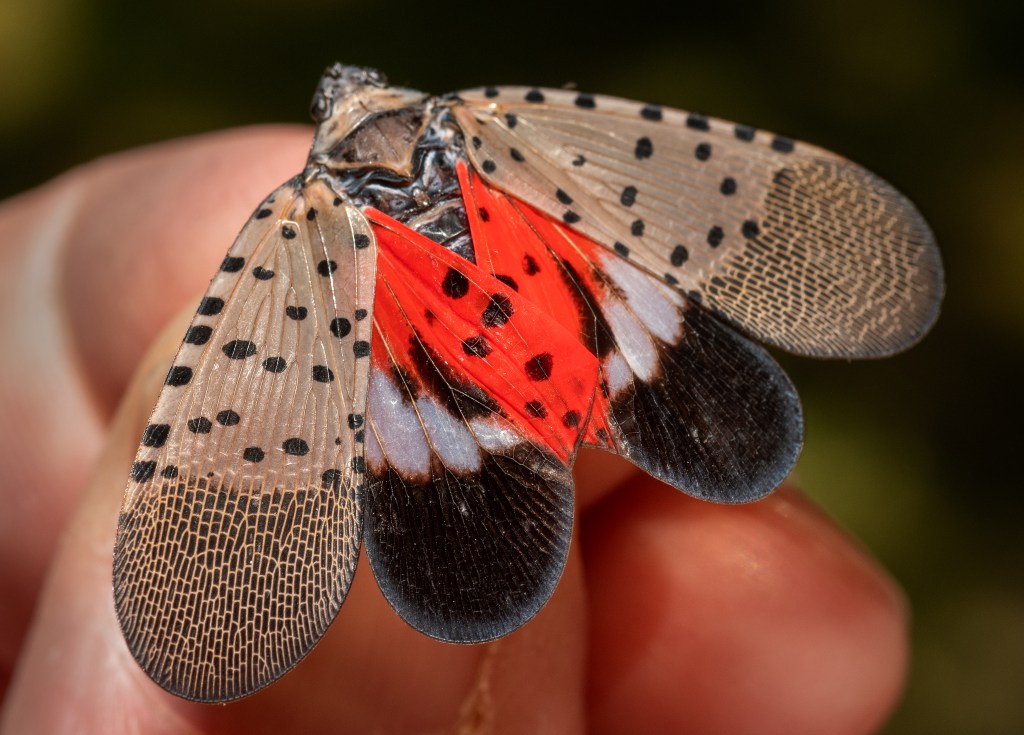While Chicagoans were alarmed to learn the spotted lanternfly had been found in Illinois last year, experts say spring is the time to take action against that insect — as well as another damaging invasive species that has made far more inroads and gotten less attention.
The spongy moth, formerly known as the gypsy moth, has been in Illinois for decades and can strip leaves and kill trees, sometimes defoliating large swaths of land.
Kathryn Bronsky, a national policy manager with the U.S. Department of Agriculture, said while it’s important to stop spongy moths from killing trees in the 20 states in which they are currently established, it’s even more important to limit the insect’s expansion across the United States.
Bronsky said spongy moths usually spread around the country in the form of egg masses.
“Egg masses get laid on everything,” Bronsky said. “They can lay them on your barbeque or your backyard grill, on your patio furniture, things you’d think there’s no way caterpillars could be on.”
Egg masses are usually a cream color, according to Greg Dwyer, a professor of ecology and evolution at the University of Chicago, and appear spongy, with small holes across the surface. Both the spotted lanternfly and the spongy moth lay eggs in masses, but where the lanternfly may lay as many as 60 eggs, the moth can lay up to 1,000.
These eggs begin hatching in spring, and the USDA is encouraging residents to report and destroy any eggs they find before the insects enter more destructive phases.
Dwyer said spongy moths feed on a variety of hardwood trees, including oaks. In some states, including Michigan, the moth has caused significant damage to hundreds of thousands of acres of forest.
“The spongy moth is extremely voracious,” Dwyer said. “And sometimes it gets up to very, very high numbers, and will deploy to vast areas.”

While Dwyer said many insects feed on foliage and trees, the moth poses a particular danger because of its sheer numbers and its preference for hardwood trees. Enough moths can eat the foliage on an entire tree, killing it over several years.
The spotted lanternfly, on the other hand, prefers items like grapes, hops and some hardwoods like walnut trees, according to Matthew Travis, the spotted lanternfly national policy manager at the USDA.
“These things are really important to a lot of communities, certainly to agricultural communities,” Travis said. “People rely on what those plants provide, whether that’s grape juice or wine, and certainly hops and beer. So the spotted lanternfly has been known to really act as a big stressor.”
Travis said the spotted lanternfly reached Chicago in 2023 and was found near railroads –– a primary pathway for invasive species. While it’s not yet clear to what extent Chicagoans will see the lanternfly this summer, Travis said it’s important to keep an eye out for the insect’s harder, darker egg masses.
“Just this weekend, we saw hatching potential in New Jersey and Pennsylvania,” Travis said. “It’ll be some time before hatching hits the Chicago area, but in May people can start looking for the insects and reporting those insects to their state department of agriculture.”

Tricia Bethke, the Morton Arboretum’s forest pest outreach coordinator, said spongy moths are best eliminated as eggs. As soon as they hatch, they can feed off millions of trees due to their numbers. While they aren’t the only factor that can contribute to a decline in forest areas, spongy moths make a significant impact when paired with other ecological threats like climate change.
“It becomes a one-two punch,” Bethke said. “If the tree is being defoliated every single year, it will grow back smaller. It’s like a bank account where you’re taking out more money than you’re putting in.”
Spongy moths usually exist in their caterpillar stage for about seven weeks, and are most active in the early summer months, according to Bethke. Adults emerge after one or two weeks and live just long enough to mate and lay eggs.
Dead or dying trees have not been as much of a problem in Illinois as in surrounding states, Bethke said, because of a partnership between the USDA, the U.S. Forest Service and the Illinois Department of Agriculture that calculates which of the state’s counties are seeing the most moths. Early-stage moths in those counties are sprayed with bacteria, preventing them from spreading.
This year, Jo Daviess County and Carroll County were identified as counties with elevated moth counts, Bethke said. Cook and DuPage counties have previously engaged in preemptive spraying, according to Bethke, and are now seeing fewer spongy moths. That preemptive spraying, as well as pheromone spraying and trapping which stops the moths from mating, is why spongy moth numbers in Illinois have tended to stay low, Dwyer said.
“The reason why we’re talking about it now is because the spring seasons are when we see the eggs forming,” Dwyer said. “The insect only got to the Midwest in the 1980s, and has been gradually spreading across the country. The more moths that hatch, the more danger there is.”
When spongy moths are eliminated in the egg stage, there is also less chance people might accidentally spread them, Bronsky said.
She said it’s important for Illinois residents to keep an eye out for these masses, removing them from trees as well as outdoor items and furniture and disposing of them in a sealed container.
“They are excellent hitchhikers,” Bronsky said. “People don’t even know that they’re spreading them to new areas. It’s really mandatory to look for these egg masses, scrape them off, and certify that you’re moving household goods free of spongy moth egg masses.”
